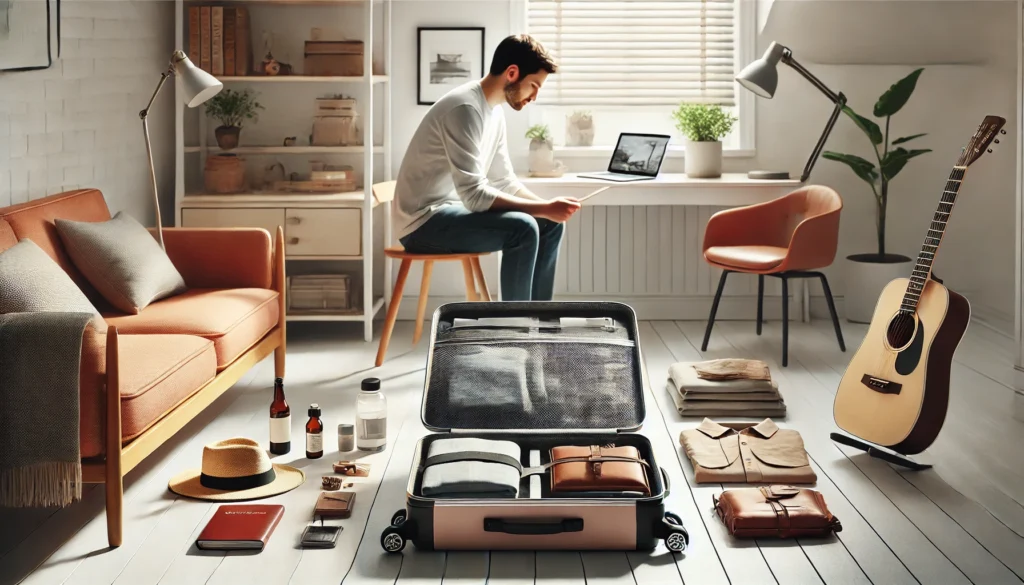Packing light is an art that every traveler should master. Whether you’re heading on a weekend getaway or a month-long adventure, learning to pack light can make your travels more enjoyable and stress-free. No more dragging around heavy suitcases, struggling to fit your bag in overhead compartments, or paying extra for checked luggage. In this comprehensive guide, we’ll cover everything you need to know about packing light, including tips, tricks, and a step-by-step plan to ensure you have everything you need without the excess weight. So, grab your favorite carry-on, and let’s get started!

Chapter 1: The Benefits of Packing Light
Before diving into the how-tos, let’s talk about why packing light is so beneficial:
- Ease of Movement: Navigating airports, train stations, and city streets is much easier with a lighter bag. You can move quickly, avoid extra baggage fees, and have less strain on your body.
- Flexibility: With just a carry-on, you’re more adaptable to changes in plans, whether it’s catching an earlier flight or hopping on a last-minute bus.
- Less Stress: Less luggage means fewer items to keep track of and less risk of losing something. It also simplifies packing and unpacking at each destination.
Chapter 2: Choosing the Right Luggage
The first step to packing light is choosing the right luggage. Here are some tips:
1. Size Matters: Aim for a carry-on suitcase or a backpack that fits within the airline’s size limits for carry-on luggage. Generally, this means a bag no larger than 22 x 14 x 9 inches.
2. Weight: Look for lightweight luggage options. Some suitcases are heavier even when empty, so opt for materials like polycarbonate or durable nylon.
3. Compartments: Bags with multiple compartments can help keep your items organized and easily accessible.
4. Wheels or Straps: Decide whether you prefer a wheeled suitcase or a backpack. Wheeled suitcases are easier on your back, but backpacks can be more versatile and maneuverable.
Chapter 3: Creating a Packing List
A well-thought-out packing list is crucial for packing light. Here’s how to create one:
1. Research Your Destination: Consider the weather, cultural norms, and activities you’ll be doing. This will help you decide what clothing and gear you need.
2. Essential Categories: Divide your list into categories such as clothing, toiletries, electronics, documents, and miscellaneous items.
3. Stick to the Basics: Focus on versatile pieces that can be mixed and matched. Avoid packing items that you’ll only wear once.
4. Limit Shoes: Shoes can take up a lot of space and add weight. Stick to two or three pairs that cover all your needs (e.g., walking shoes, casual shoes, and dress shoes).
Chapter 4: Clothing Strategies
Packing light means being strategic with your clothing choices. Here are some tips:
1. Layering: Instead of bulky items, pack lightweight layers that can be added or removed depending on the weather.
2. Color Coordination: Choose a color scheme so that all your clothes can be mixed and matched. Neutrals are usually a safe bet.
3. Multi-purpose Items: Look for clothing that serves multiple purposes, like a scarf that can double as a blanket or a dress that can be dressed up or down.
4. Laundry: Plan to do laundry during your trip. Packing enough clothes for a week, regardless of the trip length, can significantly reduce the load.
Chapter 5: Toiletries and Personal Care
Toiletries can quickly add weight and take up space. Here’s how to manage them:
1. Travel Sizes: Invest in travel-sized bottles or transfer your products into smaller containers.
2. Multi-use Products: Use products that serve multiple purposes, like a shampoo and conditioner in one or a moisturizer with SPF.
3. Hotel Amenities: Take advantage of hotel toiletries when available, and consider buying items like toothpaste or shampoo at your destination.
4. Minimal Makeup: If you wear makeup, bring only the essentials. A neutral palette can cover all your needs.
Chapter 6: Electronics and Gadgets
Electronics are often necessary but can be bulky. Here’s how to pack smart:
1. Dual-purpose Devices: Choose devices that serve multiple functions, like a smartphone that can be used as a camera, GPS, and entertainment.
2. Minimize Cables: Use multi-port chargers and universal adapters to reduce the number of cords and plugs you need.
3. Lightweight Options: Opt for lighter versions of your electronics. For example, consider an e-reader instead of multiple books.
4. Backup Power: Bring a portable power bank to keep your devices charged on the go.
Chapter 7: Packing Techniques
How you pack your items can make a big difference. Here are some techniques:
1. Rolling vs. Folding: Rolling clothes can save space and reduce wrinkles. For bulkier items, folding might be more efficient.
2. Packing Cubes: These help organize your bag and compress your clothes, making more room for other items.
3. Wear Your Bulkiest Items: Save space in your bag by wearing your heaviest and bulkiest items on travel days.
4. Utilize Empty Spaces: Fill shoes with socks or small items, and use every inch of your bag efficiently.
Chapter 8: Travel Documents and Essentials
Keep your important documents and essentials organized and accessible:
1. Passport and ID: Always have your passport, ID, and any necessary visas in a secure but easily accessible place.
2. Travel Wallet: Use a travel wallet to keep your money, cards, and important documents together.
3. Copies: Keep digital and physical copies of important documents like your passport, travel insurance, and itinerary.
4. Travel Insurance: Ensure you have travel insurance that covers medical emergencies, trip cancellations, and other unforeseen events.
Chapter 9: Entertainment and Comfort
Long journeys can be more enjoyable with the right entertainment and comfort items:
1. Reading Material: Bring a book, magazine, or e-reader to pass the time.
2. Headphones: Noise-canceling headphones can make a big difference, especially on long flights.
3. Comfort Items: Consider a travel pillow, eye mask, and earplugs for better rest.
4. Snacks: Pack some healthy snacks to avoid overpriced airport food and stay nourished on the go.
Chapter 10: Packing for Different Types of Trips
1. Weekend Getaways: For short trips, focus on the essentials and pack only what you’ll need for a few days. A small carry-on should suffice.
2. Business Trips: Pack versatile, professional clothing that can be mixed and matched. Use packing cubes to keep everything organized and wrinkle-free.
3. Adventure Trips: If you’re heading on an adventure trip, pack lightweight, durable clothing and gear. Consider a backpack with multiple compartments for easy access to your essentials.
4. Long-term Travel: For extended trips, pack versatile clothing that can be layered. Plan to do laundry regularly, and bring multi-purpose items to save space.
Chapter 11: Sustainability and Packing Light
Packing light can also be more sustainable. Here’s how to make eco-friendly choices:
1. Reusable Items: Bring a reusable water bottle, shopping bag, and utensils to reduce waste.
2. Eco-friendly Toiletries: Opt for biodegradable and refillable toiletries.
3. Second-hand Gear: Consider buying second-hand travel gear or clothing to reduce your environmental impact.
4. Conscious Choices: Pack items that are durable and will last throughout your trip, reducing the need for replacements.
Chapter 12: Final Tips and Tricks
Here are some final tips to ensure you pack light and smart:
1. Make a Checklist: Use a checklist to ensure you don’t forget anything important.
2. Pack Early: Start packing a few days before your trip to avoid last-minute stress.
3. Review and Edit: Lay out everything you plan to bring and remove any non-essentials. Aim to cut your initial packing list by a third.
4. Stay Flexible: Be prepared to adapt and adjust your packing based on your experiences and needs.
Chapter 13: Personal Experiences and Lessons Learned
As someone who loves to travel, I’ve learned a lot about packing light through personal experience. Here are a few lessons I’ve learned:
1. Overpacking Regrets: On my first solo trip, I overpacked and regretted carrying heavy luggage. It taught me the importance of packing light.
2. Versatility is Key: I once traveled with a friend who packed only versatile clothing, and I saw firsthand how much easier it made her travels. I’ve adopted that approach ever since.
3. The Joy of Minimalism: Packing light has made me appreciate the simplicity and freedom of having fewer belongings. It allows me to focus on experiences rather than possessions.
4. Continuous Improvement: With each trip, I refine my packing list and techniques, learning what works best for different types of journeys.
Chapter 14: Packing Light for Specific Destinations
1. Tropical Destinations: Pack lightweight, breathable clothing, swimwear, and sun protection. Leave heavy items behind.
2. Cold Climates: Focus on layering. Bring thermal wear, a good-quality jacket, and waterproof shoes.
3. City Breaks: Opt for stylish yet comfortable clothing. Consider versatile outfits that can transition from day to night.
4. Nature Trips: Pack durable, moisture-wicking clothing and sturdy footwear. Don’t forget insect repellent and a first aid kit.
Chapter 15: Conclusion
Packing light for any trip is an essential skill that can greatly enhance your travel experience. By carefully selecting your luggage, creating a thoughtful packing list, and using smart packing techniques, you can enjoy the freedom and flexibility that comes with traveling light. Whether you’re embarking on a short weekend getaway or a long-term adventure, the tips and strategies in this guide will help you pack efficiently and effectively.
Remember, the goal of packing light is to simplify your travels and focus on the experiences rather than the belongings. With practice and a bit of planning, you’ll be able to master the art of packing light and enjoy the countless benefits it brings.
Happy travels!


